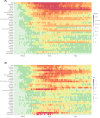The emergence and transmission of COVID-19 in European countries, 2019-2020: a comprehensive review of timelines, cases and containment
- PMID: 34333650
- PMCID: PMC8385807
- DOI: 10.1093/inthealth/ihab037
The emergence and transmission of COVID-19 in European countries, 2019-2020: a comprehensive review of timelines, cases and containment
Abstract
When it emerged in late 2019, COVID-19 was carried via travelers to Germany, France and Italy, where freedom of movement accelerated its transmission throughout Europe. However, effective non-pharmaceutical interventions introduced by European governments led to containment of the rapid increase in cases within European nations. Electronic searches were performed to obtain the number of confirmed cases, incident rates and non-pharmaceutical government measures for each European country. The spread and impact of non-pharmaceutical interventions throughout Europe were assessed and visualized. Specifically, heatmaps were used to represent the number of confirmed cases and incident rates for each of the countries over time. In addition, maps were created showing the number of confirmed cases and incident rates in Europe on three different dates (15 March, 15 April and 15 May 2020), which allowed us to assess the geographic and temporal patterns of the disease.
Keywords: COVID-19; Europe; SARS-CoV-2; non-pharmaceutical interventions; pandemic.
© The Author(s) 2021. Published by Oxford University Press on behalf of Royal Society of Tropical Medicine and Hygiene.
Figures


References
-
- Covid-19 confirmed cases in Finland and other countries. Helsenki Times, 2020. Available at https://www.helsinkitimes.fi/finland/finland-news/domestic/17271-first-c... [accessed July 2020].
Publication types
MeSH terms
LinkOut - more resources
Full Text Sources
Medical
Miscellaneous

